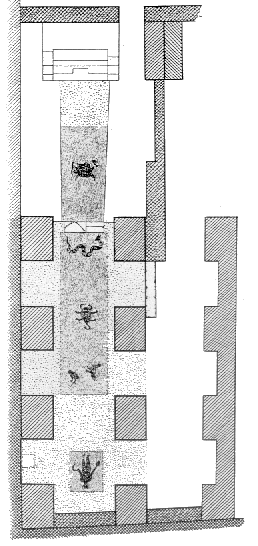|
The Mithraeum of the Animals was excavated by Carlo Ludovico Visconti in 1867. It was set against the wall surrounding the Field of the Magna Mater, in a hall with three rows of brick piers and pilasters. The shrine was entered through two openings between the piers (a third opening was blocked by a thin wall of opus latericium). Next to the altar is a secondary entrance. Podia were found only in the back part, in front of the altar (l. 4.50, w. 1.50). The brick altar was set against the back wall (w. 2.40). In the front part are three treads. In the centre of the second tread is a rectangular niche (w. 0.50, d. 0.17). The back part is a podium, that - witness a few traces - carried a niche (d. 0.90) flanked by pilasters. The entire structure was revetted with white marble.
On the floor, between the piers and the podia, is a black-and-white mosaic. It contains a marble threshold at the point where the podia begin. There are five depictions, from south to north: Near the altar a head of Mithras with Phrygian cap was found (h. 0.45). In the cap are holes for metal rays, so Mithras is depicted as Sol Invictus. Furthermore a head of Sol-Helios was found, with seven holes for rays. The shrine was built in the second half of the second century AD. |
 Plan of the mithraeum. SO II, fig. 19. |










